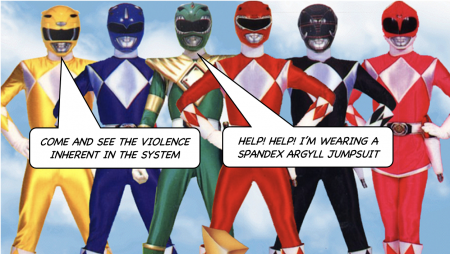Power structure
Very closely related to Thomas Kuhn’s[1] “paradigm”, Dr. Laurence J. Peter’s[2] “hierarchy” and John Gall’s[3] “system” a power structure is the self-organised structure that forms around a particular social purpose.

|
This can be obvious and institutional, as with a political organisation, a corporation or the academy — but it can be small-time: a spontaneous self-organisation of like-minded souls around a common interest: a church choir, a cricket club, a student union — even a chat forum or a prevailing friend group. Indeed, all power structures start off as spontaneous comings-together of people having a common interest.
That is to say, we all participate in power structures great and small, important and trivial, and they intersect, overlap, correlate, or bear no relation to each other. There are power structures of power structures, even.
The “power” conferred by a power structure only has currency within the power structure. Put a Nobel-prize winning astrophysicist on a cricket pitch, and her power derives only from her skill and experience at cricket. No-one cares, for the time being, about her facility with string theory.
Some power structures easier to avoid than others. If you dislike cricket and despair of cricket administrators, it is little effort to stay away from cricket clubs and all will be well. Not so if you dislike taxation, for example.
Even people who complain about power structures — at least ones who do in an organised and compelling way — have a power structure. Critical theory is a power structure, made up of lots of little power structures. Power structures often outgrow their original purpose, because it is not the purpose but the power that is exciting.
Frontiers, utopian anarchy and why this time isn’t different
Nascent power structures don’t have a steady state, and take a while to settle down, usually only settling into a format quite removed from the utopian aspiration that might have brought the common interest together in the first place.
We live in an era of technological and political change. It has been going since the industrial revolution. The utopian narrative over that time has been — and continues to be — that emerging technology will democratise: it will wrest power from the elite and distribute it to the masses.
It might do the former, but its success at the latter tends to be transitory and distressingly brief. But this is to ignore history and the cold evolutionary logic of the complex adaptive systems that we inhabit. Utopian dreams grow cold. It is better to know this and not be disappointed about it.
America is the archetypal utopian anarchy. It doesn’t The wild west was tamed by the railroad. The pattern has repeated: the telegraph, jazz, rock ’n’ roll, free love, computing, micro-computing, women’s movement, file sharing, the internet the metaverse, the cryotoverse. All of these start with a grand narrative: the promise of radical change: the redistribution of wealth and social power. But narratives need direction and the more is at stake, the more quickly will leaders, svengalis, power structures and power brokers emerge. These are the monopolistic forces of scale. Those who acquire power will acquire more of it: wealth begets wealth. The utopian state of equal empowerment is not stable.
The requirement for faith ... By the punters
A core component of any viable paradigm or power structure is unalterable tenets: a set of convictions, devout beliefs or articles of blind faith that must be held by persons in the power structure other than those in positions of power.[4]
So permissionless blockchain requires a conviction that crypto is going to the moon, to be held by those who buy crypto, but not those by those who sell it for fiat (miners) or make markets in it (intermediaries and brokers).
Same goes for financial markets (re issuers and brokers)
Same goes for law: doctrines must be faithfully applied by users, can be adjusted by judiciary
Same goes for faiths (shamen need not and often do not subscribe literally to the unalterable requirements of their faith; as long as they publicly do nothing to undermine it).
See also
References
- ↑ The Structure of Scientific Revolutions
- ↑ The Peter Principle: Why Things Always Go Wrong
- ↑ Systemantics: The Systems Bible.
- ↑ indebted to David Rosenthal’s excellent blog post here: https://blog.dshr.org/2022/02/ee380-talk.html?m=1